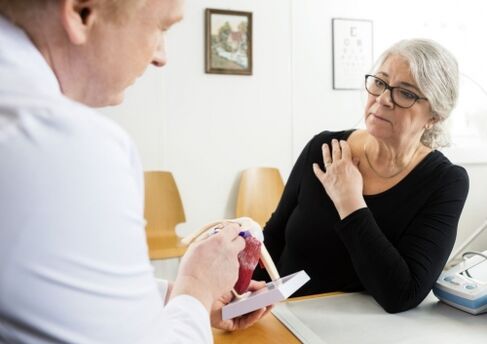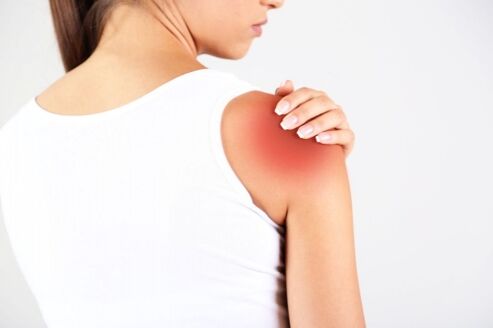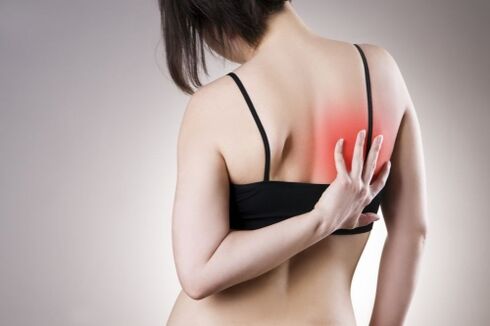The pain on the left side under the shoulder causes the suspect to immediately think of a heart attack. Of course, let’s not forget about this life-threatening condition either, but back and left pain is more likely to occur for less dangerous reasons. It’s worth getting to know why it hurts from behind under the left shoulder from behind to know which doctor to call for help and in which cases to call an ambulance.
1. Intervertebral neuralgia
The disease is accompanied by inflammation of nerve processes.
Cause
Causes nervous irritation:
- hypothermia;
- herpes infections;
- injuries to the ribs or spine;
- damage to the nerve root with thoracic osteochondrosis;
- diseases associated with chest deformity (spondylosis);
- benign tumors of the pleura;
- allergic reactions;
- osteochondrosis.
On the left side under the shoulder blade, neuralgic pain suddenly appears and frightens the person who suspects the worst.
Symptoms
In intercostal neuralgia, the pain hurts and the intensity depends on the severity of the pathology. The pain can be severe, almost unbearable, or the disease manifests as a mild painful discomfort.
Typical symptoms of inflammation or irritation of nerve processes include:
- Relationship to movement and breathing. The pain under the shoulder blade starts to hurt better when you move your left hand, cough, inhale sharply or laugh.
- The effect of heat. After warming up, the pain decreases or disappears completely.
- By touch. When pressed, it hurts more.
If the cause is a herpes infection, the patient develops characteristic rashes along the nerves.
In addition to pain, a person may experience:
- tachycardia;
- numbness of the skin;
- increased sweating.
It is not always possible to determine whether pain under the left scapula is caused by intercostal neuralgia or cardiac pathologies. If the pain syndrome first appears and you may not be in pain due to irritation of the nerve processes, you should see a doctor immediately.

Treatment
Therapy for intercostal neuralgia depends on the cause of the disease.
Patients are prescribed:
- antiviral drugs and ointments (for herpes);
- Analgesics;
- non-steroidal anti-inflammatory drugs;
- warming ointments.
If the disease is accompanied by severe pain under the left scapula that cannot be stopped by taking painkillers, patients will be blocked with novocaine to relieve the condition.
In the subacute stage, the following are used to improve tissue trophism and reduce the duration of the recovery period:
- physiotherapy procedures;
- massage;
- acupuncture.
The treatment is not only to relieve back pain under the left shoulder blade, but also to treat a provocative disease (osteochondrosis, herpes). If this is not done, the pathology becomes chronic, exacerbated by hypothermia or physical exertion.
Who to contact
If you have pain in the left shoulder area and there is no suspicion of heart pathology, you should see a neurologist.
2. Diseases of the broncho-pulmonary system
The left shoulder blade may hurt from behind due to lower respiratory tract disease (bronchus, lungs, pleura).
Cause
In the pathologies of the respiratory system, the main causes of pain are diseases caused by pathogenic bacteria and viruses:
- bronchitis;
- pneumonia;
- pleurisy.
In addition, left back pain may occur due to the appearance of tumors in the bronchi or lungs.
Symptoms
The person has constant pulling or aching pain under the left shoulder blade. If you cough and take a deep breath, the pain intensifies. In addition to left back pain, patients may experience the following symptoms:
- fever, sometimes reaching high numbers;
- dry cough or discharge of viscous sputum (there may be streaks of blood or pus in the mucous secretions);
- weakness and apathy;
- difficulty breathing.
If the left back pain causes tumors under the shoulder blade, there will be no hyperthermia, coughing and breathing problems will become additional symptoms.
Treatment
If back pain and signs of inflammation are triggered by the inflammatory process, patients are prescribed:
- antibiotics or antivirals;
- drugs for liquefying and stimulating sputum;
- antipyretic drugs;
- painkillers (if you start to get very sore).
For neoplasms, treatment depends on the nature and size of the tumor. Patients are removed for tumor formation or conservative therapy.
Who heals
Inflammatory processes in the bronchi or lungs are treated by a pulmonologist, and in the case of tumors you should see an oncologist or surgeon.
3. Vegetovascular crises
On the left side, the patient complains of pain and a feeling of fear under the shoulder blade, but no pain-discomfort can be detected during the initial examination.
Cause
Crises can go away on their own, and due to the lack of signs of organic pathology, such people are considered hysterical and unbridled. In reality, however, crises cause:
- hormonal imbalance;
- neurological pathology;
- tension;
- psycho-emotional surge;
- endocrine diseases;
- long-term use of antidepressants or psychotropic drugs.
Vegetative crises are often the first signs of neurological disorders. After intense experiences or shocks, signs of deterioration in well-being and painful discomfort under the left shoulder begin to appear. Children and women under the age of 30 suffer most from the disease.

Symptoms
In the case of a vegetative-vascular crisis, not only does the pain appear on the left side under the shoulder blade, but the patient may experience:
- feeling of suffocation;
- cardiopalmus;
- trembling in the arms and legs;
- unreasonable anxiety;
- feeling hot or cold;
- sweating;
- headache;
- black out.
Typically, patients are unable to indicate exactly where it hurts. Not only is there pain under the shoulder blade, but also under the ribs, often with radiation to the shoulder, arm or abdomen on the left side.
The crisis lasts from a few minutes to an hour and a half. In severe cases, a person has seizures.
Another danger is the fear of attack. One is afraid of unpleasant feelings, trying to observe all sorts of rituals to avoid under-shoulder pain and other unpleasant symptoms. Without treatment, the condition becomes phobic.
Treatment
The presence of seizures will be an indication for immediate hospitalization, and milder forms of vegetative vascular crises will be treated at home. Used as therapy:
- sedatives for severe fear;
- herbs to help calm down;
- antidepressants to reduce increased nervousness and anxiety.
If the crises are caused by neurological or endocrine diseases, additional therapy is chosen to eliminate the disorders that have occurred.
If the onset of the seizure is related to a stress factor, patients are also trained to respond appropriately to stressful situations and it is recommended to avoid overload.
Which doctor to go to
When panic attacks occur, you should contact a vegetarian, but not all cities have such professionals. If you are unable to seek advice from a vegetarian, you should consult a neurologist or therapist. In addition, you may need to see an endocrinologist.
4. Myocardial infarction
A life-threatening condition caused by acute ischemia and necrosis of the heart muscle. In this case, the pain under the shoulder blade and behind the sternum will be severe.
Provocative factors
The cause of such pain under the left scapula is the complete cessation of coronary blood flow in a part of the heart muscle caused by blockage of the vessel. The following pathologies can cause heart attacks:
- arteriosclerosis;
- thrombosis.
The resulting blood clot or plaque breaks down and the blood flow to the heart. Once in the small diameter coronary arteries, they close the vascular lumen and stop the flow of blood into the tissues. Lack of oxygen leads to the destruction of myocardial cells.
Symptoms
The pain is acute and throbbing, localized to the left behind the sternum. Irradiated materials:
- in the left hand;
- under the shoulder blade;
- in the lower jaw.
In case of atypical course of heart attack, irradiation is possible:
- in the epigastric region;
- in the right rear;
- in the lower abdomen.
In myocardial infarction, the pain behind the shoulder blade is not relieved by taking painkillers and is slightly reduced after taking nitroglycerin.

Treatment
The goal of therapy is to remove obstacles in the way of blood flow, reduce the focus of myocardial necrosis, and relieve pain. To do this, use:
- blood thinners;
- blood thinners;
- narcotic analgesics;
- drugs that improve the tone of blood vessels.
Other medicines are selected based on the violations that have occurred - cholesterol-lowering medicines, antihypertensive medicines, etc.
In the first hours, surgical angioplasty may be performed to reduce the focus of necrosis. Surgery allows for quick restoration of damaged blood flow and reduction of the scar after a heart attack.
Which doctor is treating you
In case of myocardial infarction, emergency hospital treatment is required in the cardiology department, where resuscitators and cardiologists select effective therapy. If a heart attack is suspected, call an ambulance immediately.
5 more reasons why your back may hurt under your shoulder blade
Consider why it may hurt from behind under the shoulder blade on the left side:
- Angina pectoris. A short-term spasm of the coronary arteries caused by stress or exercise. There are sharp pains on the left side under the scapula and behind the sternum that disappear after medication with nitroglycerin.
- Osteochondrosis of the chest region or injury. When the nerve root is pinched, diffuse pain occurs under the shoulder blade on the left side, which intensifies with movement.
- Peptic ulcer disease. The pain appears not only behind the shoulder blade but also in the epigastric region. It hurts more after eating or prolonged hunger. In addition, heartburn, unpleasant belching, nausea. After vomiting, the pain decreases slightly.
- Disease of the pancreas or spleen. With these pathologies, the left side hurts the shoulder blade and ribs. In acute pancreatitis, not only back pain but also belt pain covers the left and right hypochondria.
- Injuries. In the area of the scapula, left back injuries can cause irritation of nerve processes, and pain syndrome may recur several weeks after injury with increased exercise or hypothermia.
If you have pain from behind under your left shoulder blade, this condition should not be ignored, even if the pain is mild. Painful discomfort can be caused by a life-threatening condition.
What to do if you feel pain in your back on the left side under your shoulder blade
When pain syndrome occurs from behind under the left shoulder blade, there is no need to panic, but the condition should not be ignored. Before deciding which doctor to go to, you should try to find out exactly what is hurting on the left side under the shoulder blade. To do this, you need to identify additional characteristics of the pain:
- Localization. If there is back pain under the left shoulder blade and the painful discomfort increases after eating or prolonged fasting, the chances of heart disease are minimal.
- Intensity. Moderate pain syndrome is often accompanied by chronic diseases, but severe pain indicates a severe pathological process.
- Character. Acute pain requires immediate medical attention and the clinic should be consulted in case of tensile or aching pain.
- Relationship to movement and breathing. If it hurts more when you cough, bend forward, or move your left hand, it is a sign of spinal disease or intercostal neuralgia.
Back pain under the left shoulder blade is caused by a variety of causes and these are not always safe to life and health. Newly occurring pain syndrome under the shoulder blade on the left side may require special attention - it could be a sign of neuralgia, angina pectoris or even a heart attack. If you have any doubts about the origin of your pain syndrome, you should call an ambulance. Early medical care can help maintain health and sometimes save lives.


















































